The rice weevil is one of the world’s worst grain pests, and they regularly infest store grains on farms and in pantries in the southern United States. When you find weevils in your home, you want to get rid of them as fast as you can.
How to get rid of rice weevils? To get rid of rice weevils, you must freeze foods that might contain rice weevils and store rice, grains, beans, and grain products in airtight containers. To get rid of them in your pantry, throw out dried foods that haven’t been safely stored, vacuum the shelves thoroughly, and caulk any gaps.

If you have rice weevils in your home, don’t despair! With a few simple tricks, you can clear them out and make sure they never take up residence in your cupboard again. So read on, and soon your rice weevil problems will be a thing of the past.
What Is a Rice Weevil?
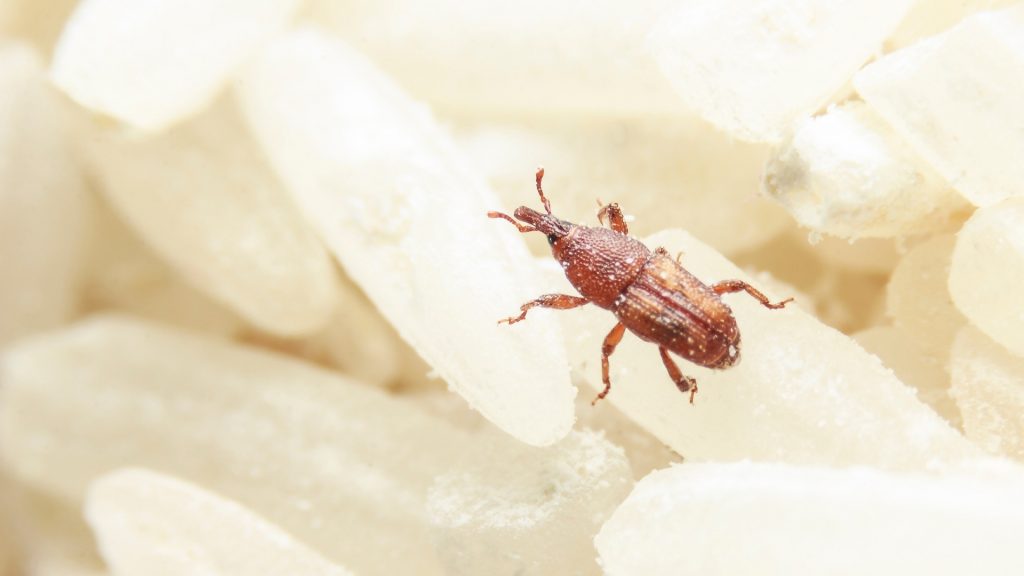
The scientific name of the rice weevil, Sitophilus oryzae, means “Rice Grain Lover” in Greek. Given a choice, a rice weevil prefers rice grains, but they’re not fussy eaters. They’ll also eat grains like wheat, corn, oats, rye, and barley. If they can’t find seeds, they’ll dine on cashew nuts, birdseed, and grain products like macaroni, bread, and flour.
Rice weevils are tiny beetles, no more than 1/16 to 1/8 inch (0.16 to 0.32 cm) long. If you look at them under a magnifying glass, you’ll see four reddish yellow spots on their back. You’ll also notice the long snout that makes up around 1/3 of the weevil’s body length.
Rice Weevil Eggs
When she’s ready to lay eggs, an adult female rice weevil eats a cavity into a seed. She then places an egg in the hole and seals it shut with sticky secretions. The female rice weevil looks for the biggest seeds she can find, but if she can’t find a seed, she may lay her egg in a piece of macaroni or even a hard-caked lump of flour.
Rice Weevil Larvae
When the egg hatches, a rice weevil larva emerges. Rice weevil larvae look like tiny grubs or maggots with soft, bloated bodies and dark heads. The larva eats the inside of the kernel or seed in which it was born, growing as it does. When it finally hollows out the grain, the larva forms a pupa (cocoon) and emerges as an adult rice weevil.
Rice Weevil Life Cycle
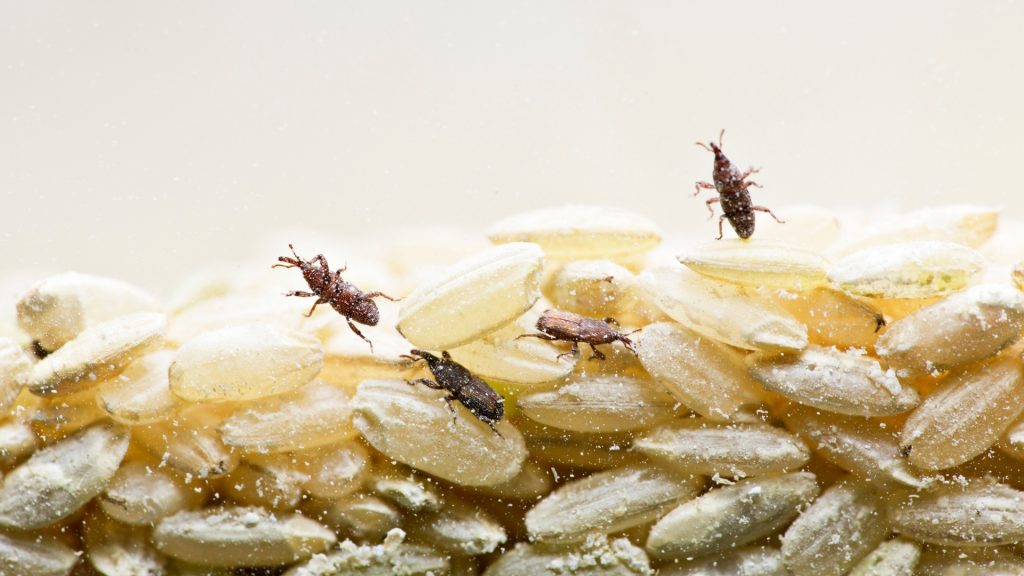
During her four to five-month lifespan, an adult female rice weevil will lay between 300-400 eggs at a rate of two to four a day. These eggs will hatch in about three days. The larvae then spend an average of 18 days eating until their kernel is hollowed out.
When the larva reaches its full size, it forms a hard shell within the kernel and rests for between five and 16 days, depending on temperature. The new adult rice weevil will remain within the seed for the next three to four days as its new shell hardens.
Rice weevils are ready to breed as soon as they shed their pupa. Within 28 days, a rice weevil generation can be completed. If a ton of rice arrives in storage with ten weevils, within a few months, that ton of rice may be home to several million nesting rice weevil larvae, and tens of thousands of adult beetles busy laying more rice weevil eggs.
Where Do Rice Weevils Come From?
Most entomologists believe rice weevils originated in the Indian subcontinent. From there, they traveled with the grain trade, and today they can be found around the world. In the United States, you can find them as far north as Tennessee and North Carolina.
Are Rice Weevils Harmful?
Rice weevils are among the most harmful and destructive pests plaguing the grain industry. When they make their way into a grain bin or elevator, they can cause almost complete destruction of the stored grain. In addition, wheat, corn, oats, barley, and other crops can become rice weevil breeding grounds and buffets.
In Southern Benin, 5.457% of rice stored for six months gets eaten by rice weevils. In 2017 9.6% of Benin’s population was food insecure, while 32% of young children showed signs of chronic malnutrition. Other countries with large rice crops and chronic food shortages face similar damage from rice weevils.
Do Rice Weevils Bite?
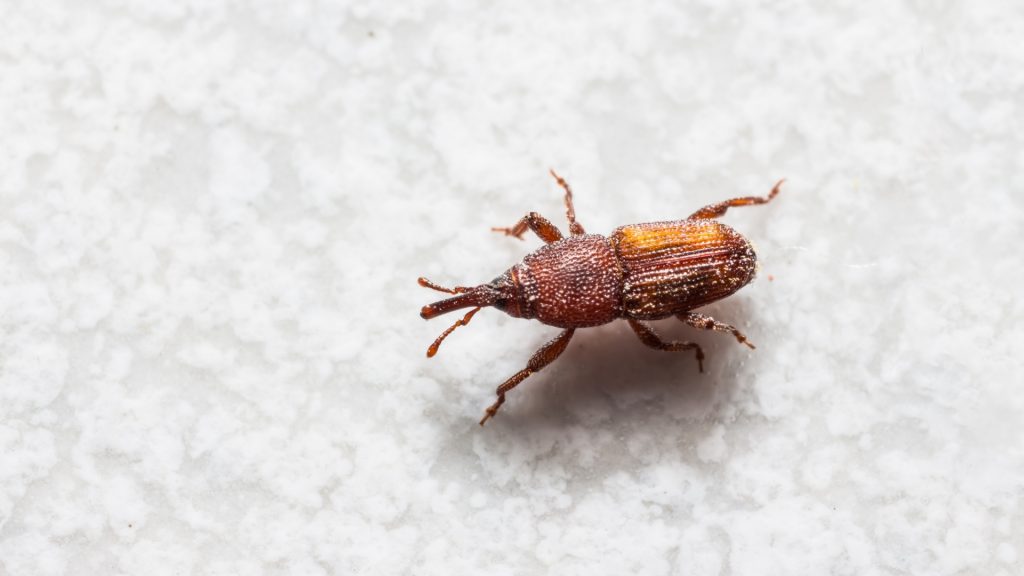
Rice weevils don’t bite or sting, nor do they carry diseases. They won’t attack pets, chew on wooden furniture or structural beams, or make clothing holes. Their mouthparts are used solely for boring into grains, not for defense or biting.
Do Rice Weevils Fly?
The granary weevil (Sitophilus granarius), the rice weevil’s cousin, can’t fly. Rice weevils, by contrast, are strong fliers. From their typical range in the southern United States, they can fly as far north as Kansas in search of food.
If the weevils in your flour bin fly out when you open the lid and head toward the nearest light bulb, you have rice weevils in your home. If they stay put, you probably have granary weevils. And if you swat at a flying rice weevil and see it fall to the ground, it’s probably playing dead. They’ll drop from the air when under attack and lay low till the danger has passed.
How To Get Rid of Rice Weevils in the House? | Rice Weevil Pest Control
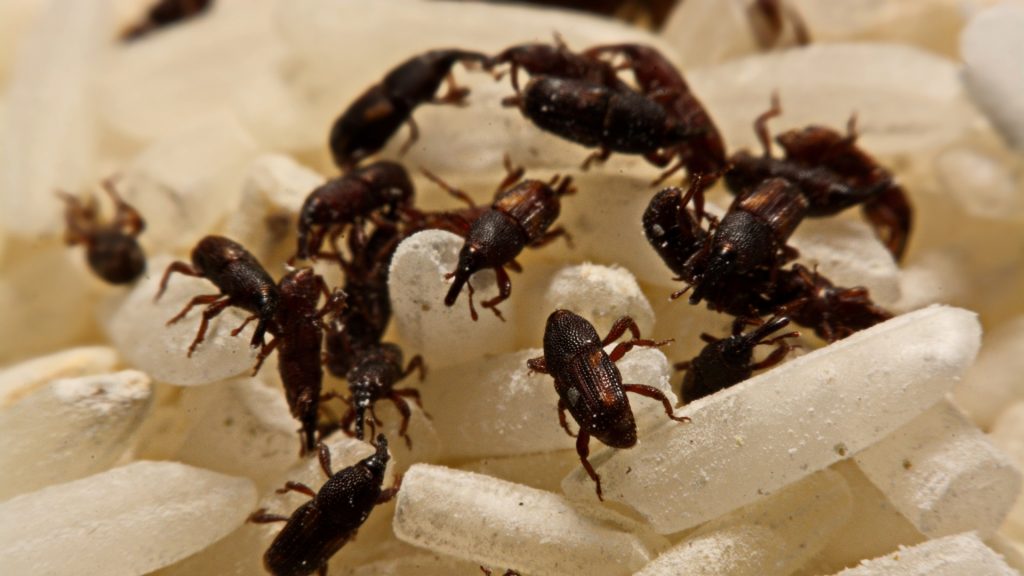
If you find rice weevils in your house, you have weevil-infested whole grain or seeds in your home. Because they’re not picky eaters, you’ll need to examine your home thoroughly. They may have taken up residence in seeds or beans in your cupboard, popcorn, old garden seeds, dried seed decorations, or decorative Indian corn.
To get rid of rice weevils in your pantry:
1. Throw out every dried food item that’s not safely stored in a tightly sealed glass or plastic container. While nobody likes to throw away food, there’s no way to know which items are or aren’t hosting rice weevils.
2. Vacuum the shelves thoroughly from top to bottom after you’ve emptied your cupboard and thrown away any food rice weevils may have contaminated.
3. Clean the edges, corners, and junctures of the shelves, as these are common hiding places for weevils.
4. Caulk any cracks or gaps which might provide weevils shelter.
When you’ve evicted your rice weevil guests, you need to make sure they don’t return. Some practical measures to avoid rice weevil infestations include:
- Before you buy food, check the package for holes, tears, or punctures. Any opening could allow weevils or other insects to enter the package and from there to your home.
- Take food products out of their original packaging and put them in tight-fitting storage containers like the Vtopmart Airtight Food Storage Containers.
- Help Organize Your Kitchen and Pantry----Imagine waking up every...
- One Set Include 7 Pieces Containers----1 Tall Container (1.7qt ),...
- Clear containers allow you to identify contents----Made of high...
- Air-Tight to keep food dry and fresh----With special sealing...
- 24 Reusable Labels ----These labels will help you never confuse...
- Try to avoid overstocking your pantry. While it’s good to have a little extra food on hand, leaving products stored for months on end in the dark increases your chances of an infestation.
How Do Weevils Get in Rice?
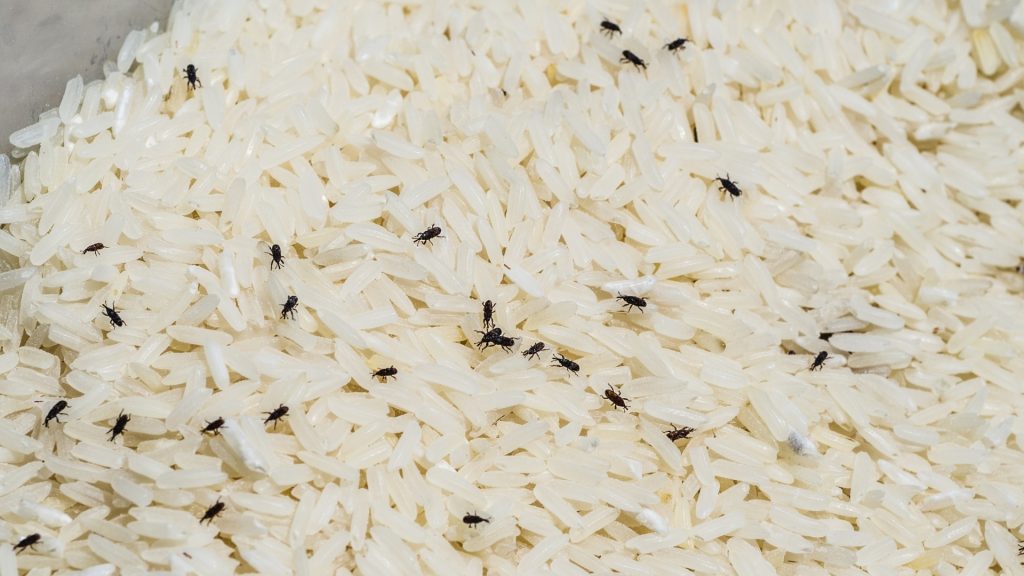
Those rice weevils you see crawling around in that just-opened bag of rice hitched a ride from the paddy. Since they can go from just-laid egg to new mother in less than a month, they can quickly occupy a rice paddy. And because rice weevil eggs are nearly invisible to the naked eye, infected rice kernels can be packed alongside healthy ones.
When you buy rice at the store, you can place it in the freezer for three to four days. Rice weevil larvae and eggs can’t survive freezing temperatures, and this deep freeze will ensure that no stragglers hatch out to give you an unpleasant surprise while cooking dinner.
How To Keep Weevils Out of Rice?
Airtight storage containers are the best way to keep weevils out of your rice and your house. Sealed containers keep them out, and if you accidentally brought home weevil-infested products, airtight storage bins will allow you to nip your infestation in the bud before they spread to nearby food items.
Can You Eat Rice That Has Weevils?
While rice weevils are unsightly pests, they’re not poisonous and don’t carry diseases. Neither rice weevil adults, larvae, nor eggs will make you sick. Though you can eat weevil-infested rice, flour, or grains in a pinch, unless it’s a dire emergency, most of us will likely throw bug-filled food out.
Rice Weevil Prevention | Rice Weevil Traps
Traps like the Black Flag Pantry Pest Trap will catch weevils, moths, and other beetles and insect pests coming after your rice and grains. These traps will cut down on the number of pests, but they also warn that an infestation is in progress. Armed with that knowledge, you can find the weevil-feeding grains and dispose of them.
- CONTAINS ATTRACTANT: Attracts and traps moths and other pests.
- EASY DISPOSAL: Check the trap weekly and replace if full; discard...
- NO KILLING AGENTS: Safe for use in kitchens, pantries and other...
- USE INDOORS: Place in common moth problem areas, such as kitchen...
How To Get Rid of Rice Weevils Naturally? | Home Remedy
Here are two time-tested natural home remedies which have been used to deter rice weevils:
- Bay leaves: The 1400S Spices Bay Leaves will provide powerful weevil repellent protection since they and many other insects loathe the smell of bay leaves. Place a few bay leaves in the corners of your cupboard. (You can use the other leaves to add flavor to sauces and risottos because while weevils despise the taste of bay, many people find it irresistible.)
- Satisfaction guarantee: If you aren't satisfied with your...
- Semi selected leaves: 4oz of whole and broken bay leaves
- Delicious taste: The incredible dry leaves are specially picked...
- Practical & versatile: These herb leaves can be used to prepare...
- Optimal solution: Cooking your favorite dishes is comfortable...
- Black pepper: Black pepper is highly toxic to rice weevils. Sprinkling black pepper in your cupboards may make you sneeze once in a while, but it’ll make your unwanted weevil guests die and chase out survivors.
- Coarse grind black pepper makes for bold presentations on a...
- 18 - 24 Mesh Size
- Great for flavoring chicken, steaks and vegetables
- Large Commercial Size 5 Lb Jar
- All Natural - Certified OU Kosher
Summary
Rice weevils are a problem for grain farmers and silo keepers. When you have rice weevils in your pantry, they’re a problem for you. But now that you know how to get them out and keep them from coming back, they’re no longer an insurmountable problem.
You can use airtight containers to protect your food, use traps to prevent them from getting into your rice and grains, and you can even use bay leaves and peppers which you’re likely to have in your kitchen.
List of Sources
Iowa State University and Extension. Rice Weevil and Granary Weevil.
Koehler, P. G. (2018). Rice Weevil, Sitophilus oryzae (Coleoptera: Curculionidae). University of Florida, Institute of Food and Agricultural Sciences.
Oklahoma State University Entomology Department. Rice Weevil, Sitophilus Oryzae.
US Department of Agriculture. (2015). Stored-Grain Insect Reference.
- How to Get Rid of Copperheads | Practical Guide - August 27, 2023
- How to Get Rid of Corn Snakes | What Makes Them Aggressive? - August 27, 2023
- How to Get Rid of Alligators | Safety Measures and Removal Methods - July 16, 2023




